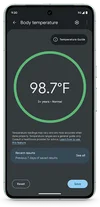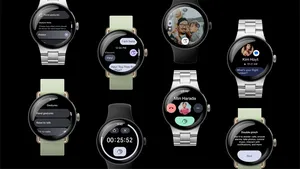How we built and tested body temperature on Pixel 8 Pro

Jim Taylor, a research scientist with Google Health, knows a thing or two about taking temperatures. That's because in addition to his role at Google, he's also a pediatrician. “The first thing I ask a parent when they call and say ‘My child has a fever’ is ‘What’s their temperature?’” he says.
For six years, Jim has been part of the team at Google Health working to bring health tools to Pixel phones. One of the first of those tools is the new body temperature feature in the Thermometer app for Pixel 8 Pro. Part of the January Pixel feature drop, it allows you to quickly scan a person’s forehead with your phone and measure the body temperature. In clinical trials, our software algorithm was able to calculate body temperature in the range of 96.9°F - 104°F (36.1°C - 40°C) to within ±0.3°C when compared with an FDA-cleared temporal artery thermometer. In layman's terms, this means the Pixel body temperature feature is about as accurate as other temporal artery thermometers.
Ravi Narasimhan, a research and development technical lead at Google, developed a miniaturized device that included an infrared sensor for body temperature measurement, which eventually evolved to become a feature for the Pixel phone. “You always have your phone with you, so it’s more convenient to measure body temperature without an additional device,” says Ravi.
Last month, we received the FDA’s De Novo classification 1 for our body temperature app, the first for smartphones in the U.S. And as of this week, it’s now available on Pixel 8 Pro. Here's a look at how the team built and tested it.
How we built the first smartphone body temperature app
Bodies emit infrared radiation — or, simply put, heat. The Pixel 8 Pro team added an infrared sensor to the phone next to the rear camera, which at launch was used to power the object temperature feature and now powers the body temperature feature as well. Measuring body temperature on the Pixel 8 Pro is simple: Just point the rear camera at the forehead and sweep across. The Pixel 8 Pro body temperature app accurately measures your temperature by scanning the temporal artery, unlike less accurate forehead thermometers that are pointed at the center of the forehead. The data from the infrared sensor is passed to an algorithm to calculate the temperature that will be displayed on your device, powered by the Tensor G3 chip.
The Pixel 8 Pro’s infrared sensor’s wide field of view (more than 130 degrees) causes it to sense heat beyond the forehead when the phone is too far away from the forehead. “It’s basically a big cone that the sensor takes in,” Ravi says. “Arteries are relatively small, so the closer you are, the more accurate reading you will get.”

The team wanted users to hold the phone close to their foreheads without touching. “We want this to be contactless to prevent the spread of germs, and we found in testing that telling someone to bring their phones within a half inch of their forehead just by estimating was very difficult,” Toni Urban, a Pixel product manager who focuses on health experiences, explains. “When you use most apps, you’re looking at the screen — but that’s not the case here if you’re using it on your own forehead.” The solution was to use another Pixel sensor. “We decided to use the LDAF (laser detection autofocus) sensor, which typically powers the autofocus system, to detect if the phone is close enough to a person’s forehead before initiating a measurement,” Toni says. Using the LDAF sensor, the Pixel 8 Pro knows if it’s in the best position to take a reading. Additionally, the team implemented haptics and audio instructions to guide users to sweep the phone across the forehead and past the temporal artery.
The FDA De Novo grant process
The Pixel 8 Pro's temperature sensor has broad uses, but the team felt accurate body temperature readings were most important because of their health implications. Since thermometers are regulated medical devices, the team not only had to run the feature through rigorous testing, but also had to undergo an exhaustive review as part of a De Novo classification request with the FDA before we could launch the feature in the United States. As part of that process, “we had to do a clinical validation study, meaning we tested the product on a large number of participants,” Jim says.
Developing a tool that’s safe and easy to use was a big part of getting the FDA’s grant. “We built it so that it can run on the phone without any internet connection,” Toni says. “It’s something that’s available even if you are traveling or in an area without cell phone reception.” And the team also had to implement instructions that were easy to understand. “The idea was to make sure that every person can reliably use this tool,” Toni says. This approach was successful.
The team is proud of the product’s accuracy, but they are most excited about its convenience and ease of use. “Now this gives people an easy way to get their or their child’s temperature,” Jim says. “To me, that’s the best part about this.”






